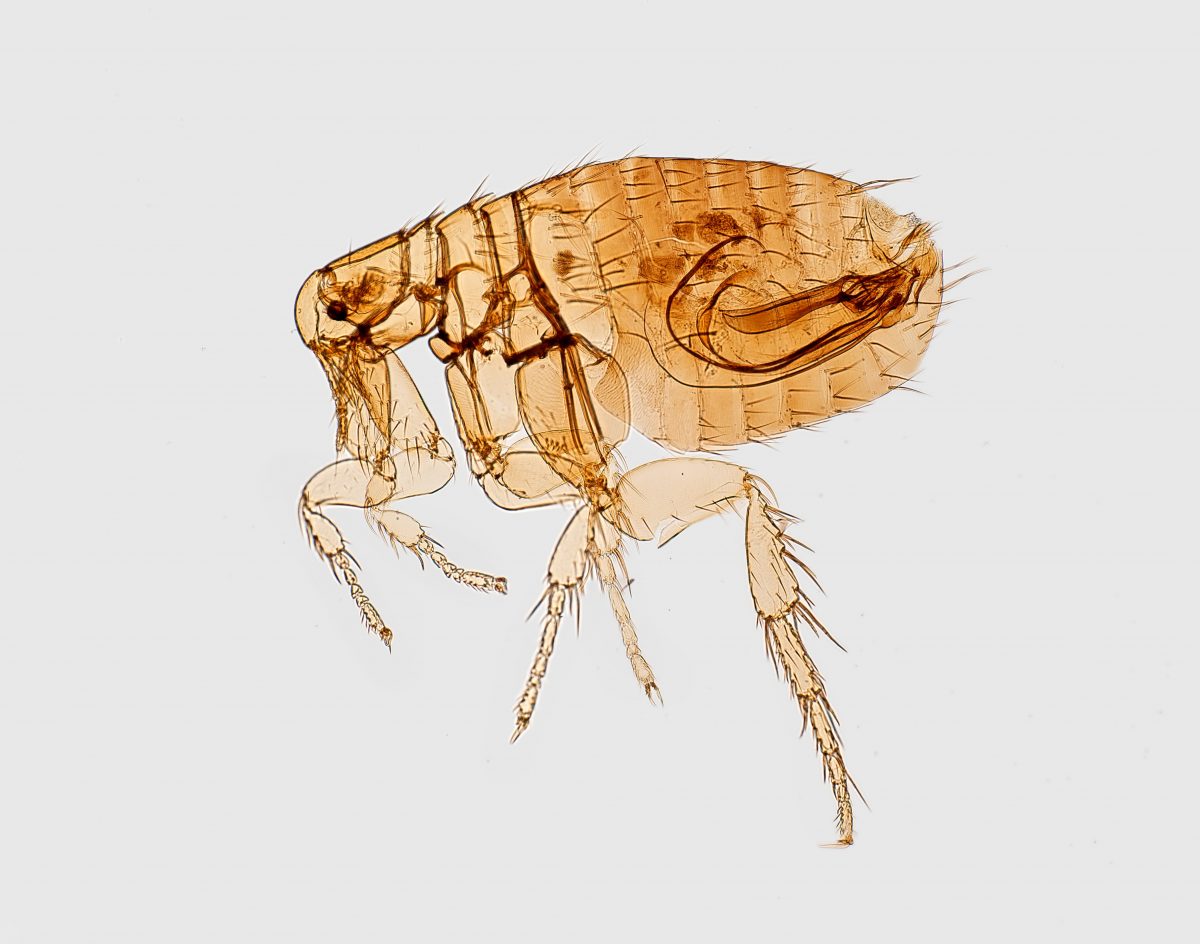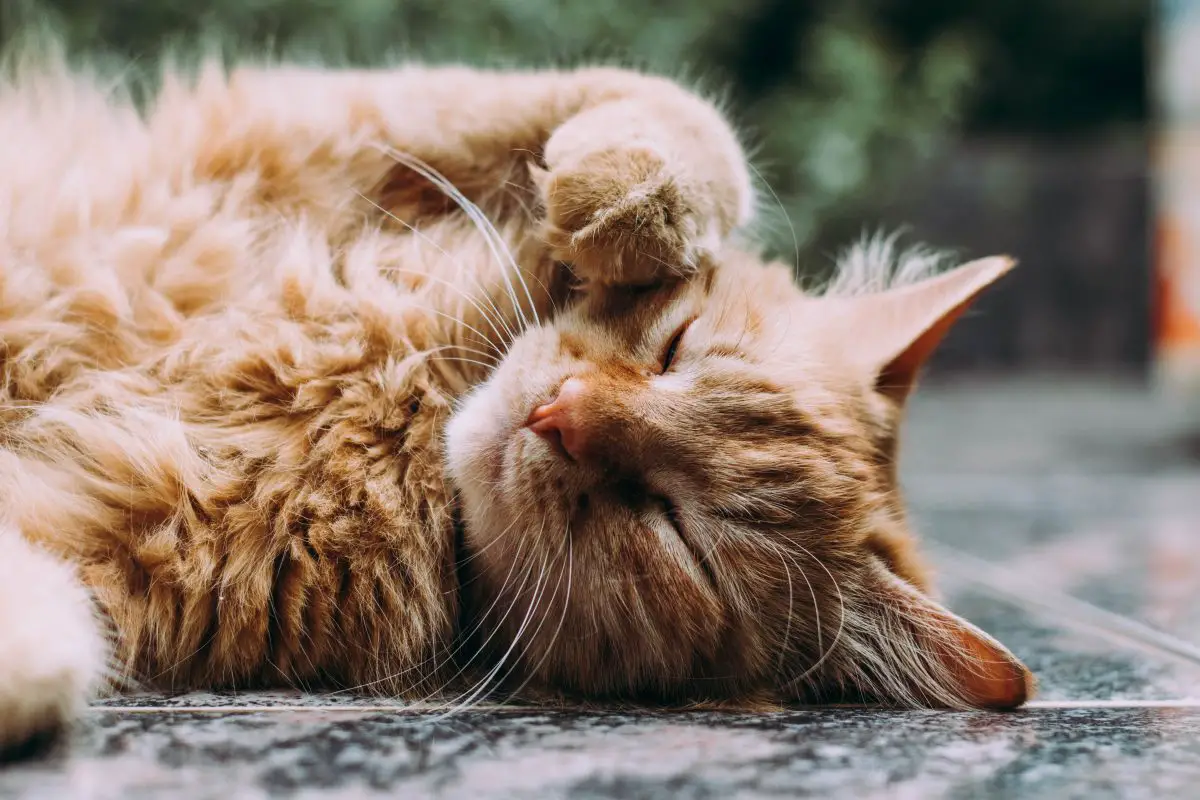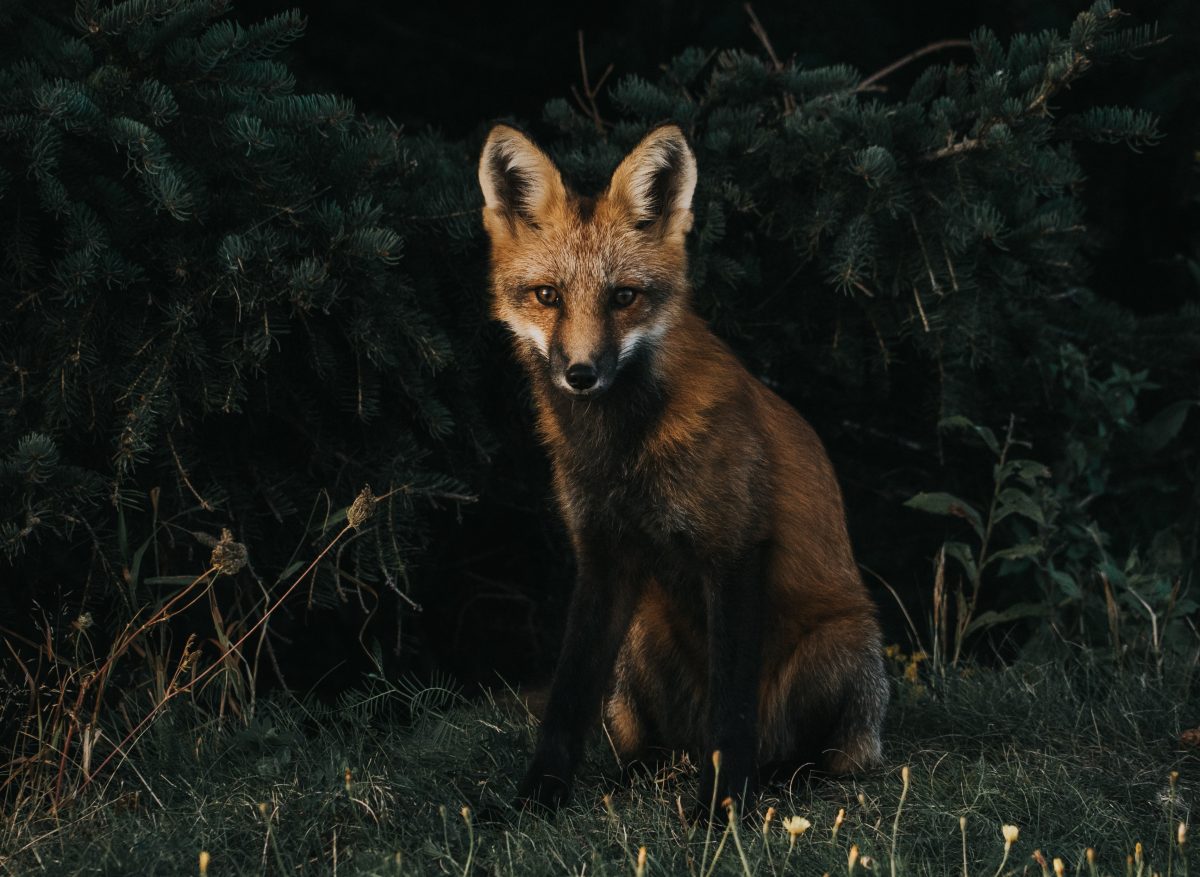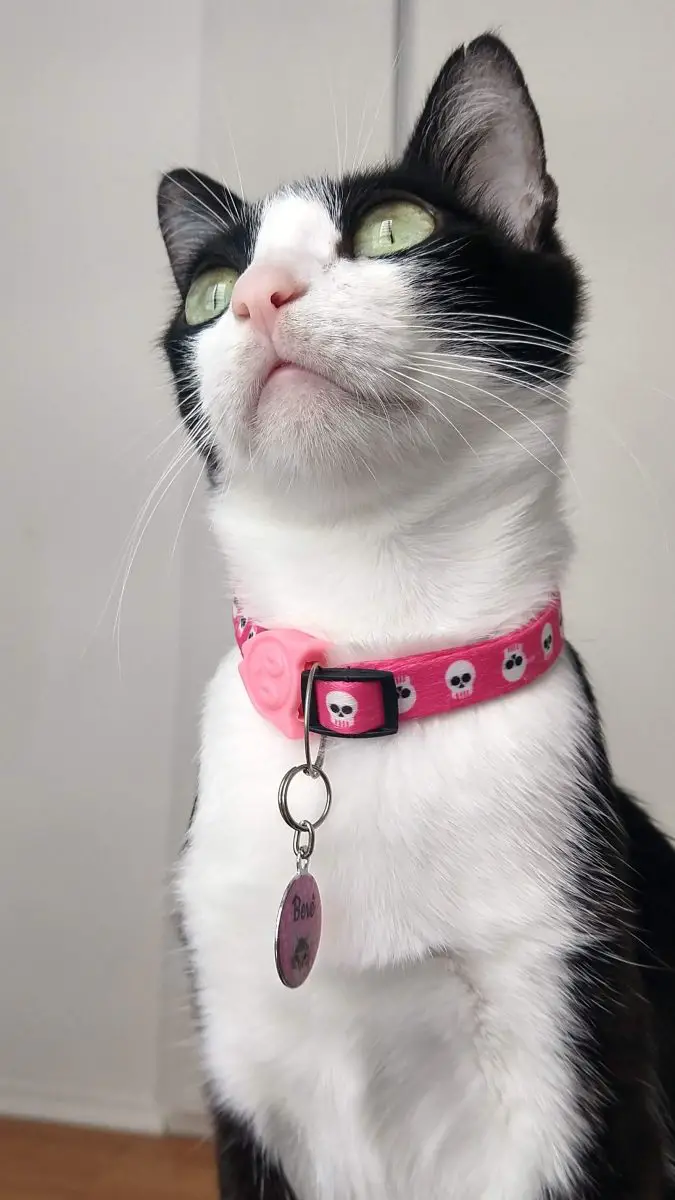As most seasoned pet owners can tell you dealing with a dog a cat flea infestation can be a nightmare. Adult fleas feed on the blood of unwilling hosts due to being parasites. Fleas prefer to inhabit dark and warm environments where they can easily hide. For this reason, adult fleas will often target pets and wild animals with a lot of fur. However, if their preferred furry hosts aren’t around they are then happy to latch on to a human host for a blood meal. Say though, that none of their food sources were around, how long can fleas live without a host?
The Flea Life Cycle
The answer to that question is not quite as simple as you’d expect. This is because fleas in different stages of the flea life cycle have different needs. As such, the duration of time a flea takes to transition from one stage of the life cycle to the next can vary.

What is the flea life cycle though? And, what are the different stages of it?
Flea Eggs
The earliest stage of this cycle is when a female flea decides to lay eggs. This begins within a couple of days of the female fleas reaching maturity and consuming their first blood meal.
On average, female fleas can lay roughly fifty eggs per day. This is why it becomes very difficult to eliminate them once a flea infestation gains a foothold in your home.
Flea eggs are typically laid in the fur of the female flea’s host. As they dry out however they will drop off the host. In homes, they will often be heavily concentrated in areas where your pet commonly resides, such as pet bedding and furniture.
These flea eggs will are roughly half a millimetre in size and white in colour. Naturally, this makes them incredibly difficult to actually spot, especially when they’re embedded in carpets or dark crevices.
Flea eggs can begin hatching within two days under ideal conditions for them. However, in less optimal conditions, such as colder temperatures it may take as long as twelve days for them to hatch.
Flea Larvae
When the flea eggs hatch, the flea larvae will emerge. These flea larvae represent the second stage of the life cycle.
They will resemble small translucent worms and are roughly one to two millimetres in size. As such like the flea eggs they can be quite difficult to actually spot.
Once the flea larvae have emerged from their eggs, they will seek out food. Typically this food will consist of the faeces of adult fleas, dead skin and any other biological material they can find.
Whilst eating, the flea larvae may also be exposed to other parasites such as tapeworms, along with diseases. Common diseases could include typhus. However, fleas can carry all sorts of illnesses and parasites, including ones as severe as the bubonic plague.
When the flea larvae are fully developed they can measure up to five millimetres in length. At this point, they will also be much darker in colour.
Once the flea larvae are fully developed, they will begin to transition into the pupal phase of the flea’s life cycle. The time it takes for flea larvae to go from hatching to the pupal stage can take between roughly two to fourteen days. This is dependent on the environment in which the larvae develops since warmer temperatures and a larger abundance of food will help them to develop quicker.
Flea Pupae
Fully developed flea larvae will enter the pupal stage by cocooning itself in gossamer. This gossamer is a similar substance to that of spider webs and such is very sticky. The cocoon’s stickiness is deliberate as it allows debris such as dust, skin cells and adult flea faeces to become attached. As a result, this layer of debris provides an extra shell of protection for the pupae.
Fleas in the pupal stage are the most difficult to rid yourself of by a long way. This is because the gossamer and hard outer debris shell will keep it both firmly rooted in place and hard to kill. As a result, hoover or insecticide spray will be near useless at exterminating the flea pupae population.
During this stage, the flea will begin its transformation from a larva into an adult flea. Fleas in this stage will also have much slower metabolisms. This means that they require no additional nourishment until they exit the cocoon.
As a result, whilst the flea normally stays in this stage for five to fourteen days during optimal conditions, nonoptimal conditions may cause them to stay as pupae even longer. These non-optimal conditions will include lower than ideal temperatures and a lack of signs that there are potential hosts available to feed on.
Under these less than favourable conditions the adult fleas within cocoons could remain dormant and waiting for up to a year.
Adult Fleas
When the adult fleas within cocoons are ready to emerge they will wait for signs that their suitable hosts are available. These signs can include exhaled carbon dioxide and vibrations in the ground caused by movement.
Once the adult fleas emerge their first goal will be to seek out food. This food will come in the form of blood from suitable hosts.
Adult fleas can vary in size, ranging from one and a half millimetres to four millimetres. They can also be brown, black or reddish-brown in colour. However, due to their tiny size, they will likely only look like dots.
Typically adult fleas will live an average of sixty to one hundred days. In ideal circumstances though individual fleas may live up to nearly a year.
Around one to two days after consuming their first blood meals the female adult fleas will begin to lay eggs. At which point the lifecycle of the flea will begin all over again.
Typical Hosts of Fleas
Adult fleas will immediately seek a host when emerging from their cocoons. However, certain fleas may have preferences for particular hosts such as cat fleas targeting cats for instance. Even in these scenarios cat and dog fleas can and often will target other hosts.
Cats
Cats with flea problems can be particularly problematic for your household. This is because they will spread them to harder to reach areas of your home.
As a result, flea control will be a much more difficult task as you will be less likely to locate and eliminate fleas from all of their hot spots.
Additionally, cats are also much more solitary creatures. This means that particularly in the case of outdoor cats they may go somewhere without supervision where they will be more likely to catch fleas.
Another complicating factor with cats is that you may be less likely to initially realise the fleas’ presence due to a cat’s more solitary nature.

Dogs
Whilst cats may put themselves in more likely positions to catch fleas, dogs may still catch them just as easily. This is especially true if they often sleep in an outdoor dog house.
Additionally, dogs being more social creatures than most cats may also cause them to catch flees due to them being more likely to approach other dogs.
With both dogs and cats though, a common hotbed of fleas in the household is pet bedding. Additionally, with both kinds of pets, flea bites may be hard to notice under fur.

Humans
Humans aren’t the most likely or even preferred host for adult fleas to live. However, the fleas will often target humans when one of their preferred hosts aren’t around for them to latch on to.
When an adult flea bites you, you may not initially notice the actual bite due to the wound being rather small. However, soon afterwards, you will likely notice some itching or bleeding and discover the bites.
The reason these bites itch is because the saliva of fleas contains an anticoagulant that will make you bleed for longer.
Vermin
Other creatures such as foxes, mice and rats may also bring fleas to your door. These fleas may be worse than ones from other sources such as pets. These will be more likely to carry diseases as a result of their hosts eating carrion or residing in the sewers.

These fleas will likely end up in your home as a result of the vermin finding their way initially into your garden, then potentially the house itself. From here the eggs would fall from these creatures and take up residence in either leaf piles or carpets, depending on where on your property the host manages to get to.
How Long Can Fleas Live Without a Host Versus With One?
The length of time, an adult flea can live heavily depends on the conditions of its environment and how easily it can access hosts. However, how long a flea will last without a host depends on the stage of the lifecycle they find themselves in without a viable host or set of hosts. This is because fleas only become reliant on having a host during the adult stage of their lives.
How Long Will Fleas Live With a Host?
With regular access to a host, an average adult flea will likely live for roughly two to three months. However, it is not unheard of for fleas to live for close to a year. For fleas to live this long though, their environment must be near enough perfect for them.
A flea’s perfect environment will be incredibly humid with a relative humidity of eighty-five percent being ideal. Additionally, temperatures of twenty-nine degrees celsius or eighty-four degrees fahrenheit are preferred. Ultimately though, regular access to a host is the most important factor since fleas need to feed constantly. This constant need for blood is why fleas tend to prefer living on their hosts.
How Long Can Fleas Live Without a Host?
Without access to a host, adult fleas will live roughly four days to a week. This is because they need a near-constant source of fresh blood. Additionally, without this supply of blood, the female adult fleas won’t be able to lay any new eggs meaning that the population will gradually decrease over time.
As a result of this, when fleas have finished the pupal stage they will likely wait for signs of a viable host being present before emerging. Again, whilst fleas prefer creatures with fur which will provide them with food, warmth and a dark place to hide, they will target humans when their options are limited.
Where Will Fleas Without a Host Live?
Fleas without a host can live in sorts of different areas. The main hotspots however are usually in areas where previous hosts would often reside. This is because when the flea hosts would go to these places, they would inadvertently leave behind flea eggs.
Below are some common locations where flea activity is more prevalent. However, fleas could potentially be anywhere once they make their way into your home.
Carpet
A classic hiding place for fleas lacking a host is in your carpets. This is because the fibres of a carpet provide an excellent hiding place for fleas in all stages of the life cycle. Additionally, carpeted areas such as living rooms are often highly trafficked by the fleas’ hosts. As a result, more eggs will end up there.
For more information on how long fleas can live in your carpets, click here.
Furniture
Hosts of fleas such as pets and people will often inadvertently deposit fleas and their eggs onto furniture. Often, furniture is an ideal habitat for fleas to develop through the stages of the flea life cycle. This is because they not only have a steady supply of hosts but also a warm and dark environment to hide in as fleas will often gravitate towards the cracks and crevices of furniture.
Typically, the types of furniture you’ll find fleas living on includes human and pet bedding, sofas and armchairs, or other fabric furniture.
High Up Places
This is less common when fleas a brought into your home by dogs than cats since the latter is more prone to climbing than the former. As such, when attempting any form of flea control, it is wise to keep a close eye on your feline companion.

However, fleas also have incredibly strong legs. As a result, they can often reach these higher up and harder to reach locations without assistance from a host. Again these high up places often provide dark and warm hiding locations, which in a household with cats are also trafficked by viable hosts.
Gardens
In the right conditions, your garden may be an excellent place for fleas to live and expand their population. Typically they will likely get to the garden by being deposited by vermin such as rats, mice or foxes. However, pets interacting with other animals can also bring fleas into your garden.
Fleas in your garden will often lurk in areas where your pets regularly eat, sleep and play. This is especially true if said pets were the ones to bring the fleas there in the first place.
Another possibility though is that they reside under leaf or grass piles. From here, the fleas will wait for an opportunity to jump to a host. In this context they are likely to have arrived via vermin and as such may be acting as secondary hosts to other nasty parasites or diseases.
Identifying A Flea Infestation
If you suspect that your home may have a infestation of fleas there are a few signs that you can look out for. Before looking though, it is important to remember that fleas don’t fly or have wings. Instead, they merely have incredibly strong legs which allow them to leap great distances and heights.
Additionally, due to their small size, fleas are incredibly difficult to spot with the naked eye. As such you should be on the lookout for collections of tiny black or brown dots.
On Pets
A classic sign that there are fleas in your home is if your pets are licking, scratching or biting themselves more frequently than you would normally expect. If this is the case it might be time to take a closer look at your pet’s fur.
If the fur almost looks like it is covered in a substance like black pepper then this could be fleas. To confirm brush the pet fur with a fine-toothed comb. Doing so should catch the fleas on the comb and make them easier for you to identify.
On Yourself
Flea bite marks on humans look somewhat distinctive. These bites will resemble red bumps that will be incredibly itchy and may have red halos surrounding them if bitten multiple times in close proximity.
The area around the bite may also swell or come out in a rash or hives. Additionally, some people are allergic to the saliva of fleas. Reactions to this allergy can include swelling of the face, mouth and hands. Additional symptoms may also include severe rashes or hives, intense itching and wheezing/shortness of breath.
On Furniture
A common sign that fleas have been present on furniture such as bedding is the presence of flea faeces. Initially, these flea faeces may look like small brown or black flakes.
To confirm whether these are flea faeces simply dab the flakes with a slightly damp piece of tissue. If the flakes take on a reddish colour then they a likely flea faeces. The reason for this is that flakes will contain undigested blood.
Flea Control Methods
Fleas can be a nightmare to deal with and a particularly annoying pest whilst in your home, especially so if you have pets. However, the options you do have for dealing with this problem are quite varied.
These range in complexity from basic steps you can take immediately to incorporating either natural or chemical-based flea control solutions into your home. However, if the infestation has escalated past a point where you believe you can get it back under control, then it will be wise to consult a professional pest control company.
Basic Initial Steps
If you notice signs of fleas on your furniture or carpets, thorough and intense cleaning can help reduce the population. This is because fleas in their larvae stage often rely on biological material such as adult flea faeces or dead skin for sustenance.
Additionally whilst it likely won’t kill all flea pupae present, a thorough cleaning will help to reduce the number of fleas in the other stages of the life cycle.
There’s one thing to keep in mind when vacuuming fleas, however. Be careful to prevent any fleas captured in the process from escaping once you’re done. In conjunction with vacuuming though, steam cleaning can be very effective in killing any remaining fleas due to the extreme temperatures.
Along with cleaning your furniture, clothing, etc, bathing any pets daily whilst there are still signs of flea infestation will help reduce the number of fleas they are host to.
Natural Flea Control Solutions
Whilst plenty of flea extermination products are available for purchase, one of the most popular methods is actually homemade.
All it requires is a bowl of slightly soapy water and a light. Simply place the bowl near to a hotbed of flea activity and have the light source pointed at the bowl. Then you wait. Eventually, fleas will jump into the bowl after being attracted to the heat and light, causing them to drown.
This method only works on adult fleas since before reaching maturity, fleas tend to avoid light. However, upon reaching adulthood and leaving their cocoon they tend to be attracted to instead since their eyes are now properly developed.
Another popular natural solution is to use food grade diatomaceous earth. This a naturally occurring substance that is toxic to fleas whilst being safe around mammals. Simply spread over infested areas after vacuuming, then clean and reapply every few days to kill fleas.
Chemical Flea Control Solutions
If your pets are host to fleas then pet flea collars are a good option. These occasionally release chemicals that are toxic to fleas but safe for pets onto the animal’s skin.

Unlike other chemical based products for pets you don’t have to manually give a dose to your pets as these collars can last for a year in some cases. Additionally, there is much less of risk of your pet having an adverse reaction due to a human error in dosage. This can be a risk in manually applied pet based flea products.
Insect growth regulators in tandem with residual insecticides are also a reliable option. Here the growth regulators interfere with the pupal stage of of the flea life cycle and cause them to emerge before developing the ability to reproduce.
These can take a while to kick in, however. So using residual insecticides to kill the current generation of adult fleas whilst the growth regulators ensure the next cylce are unable to propagate is an effective option.
When buying any of these products, it is important to ensure that they are safe for use around humans and pets. However, in the majority of cases they are designed with these kinds of homes in mind.
Fighting Back Against Fleas
Now you know how long fleas can last without a host along with how to start combating them. Whether you’re pet owner or not fleas can make your home an unpleasant place to be.
As such, the next step should be to get rid of them or taking steps to prevent fleas from infesting your home before it’s too late.
